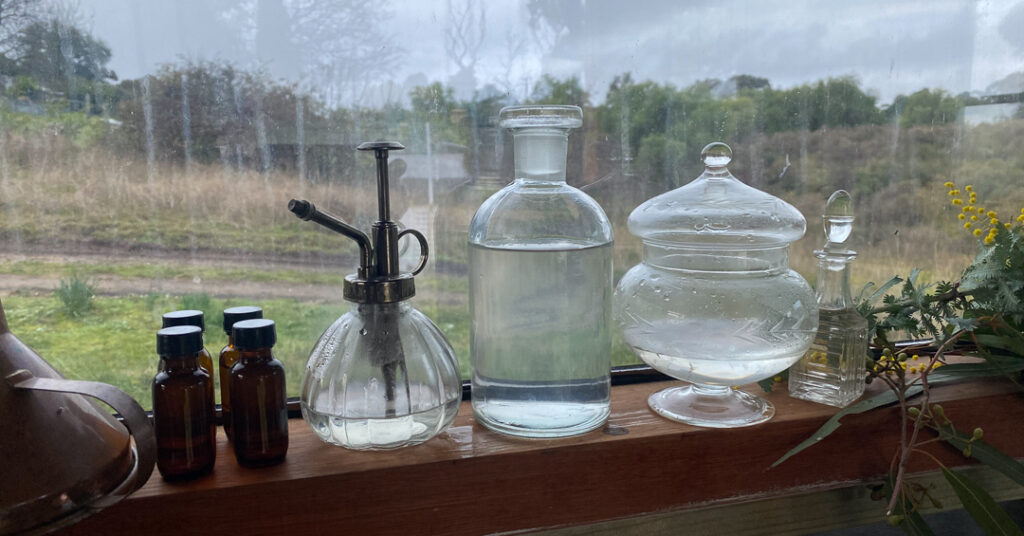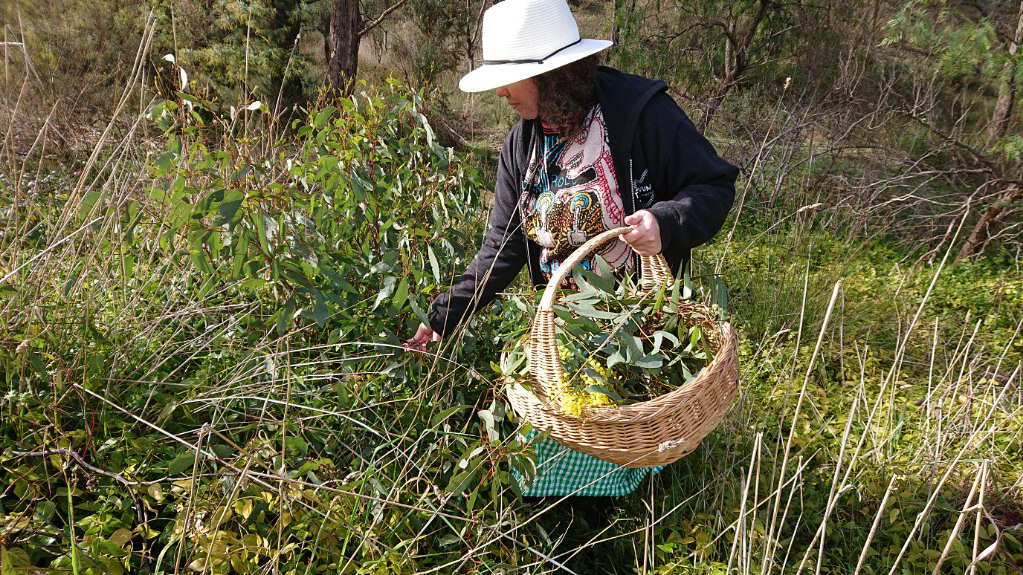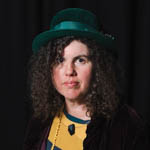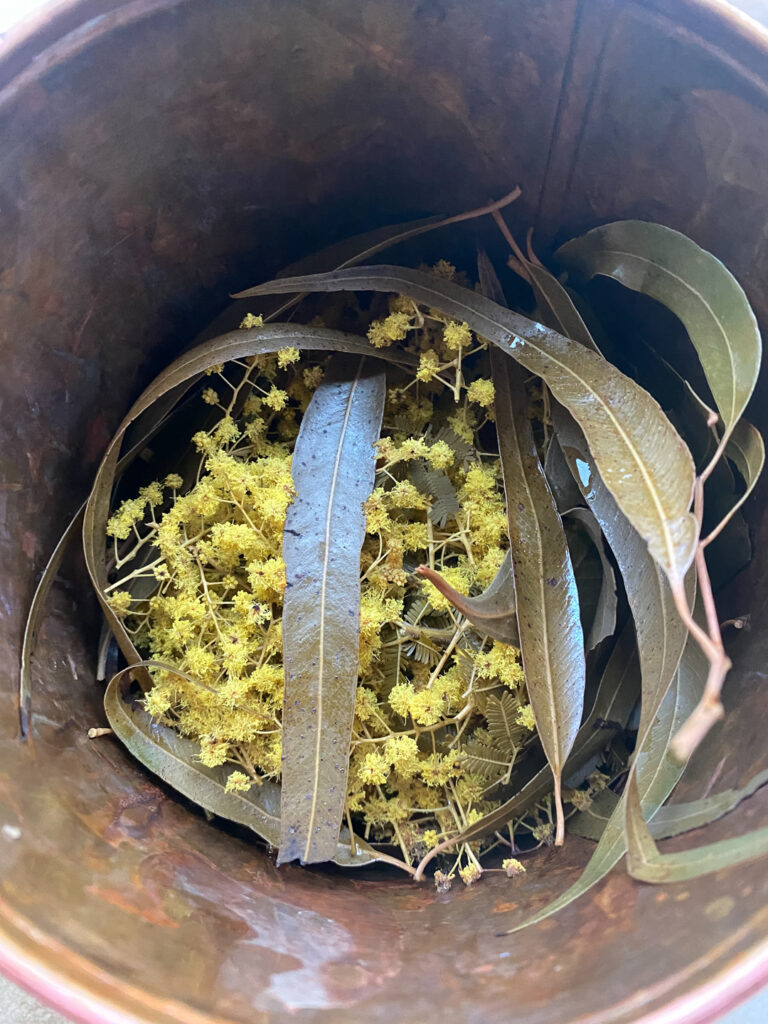
Forest Keegel distils plant hydrosols as a way of being withinCountry.
(A message to the reader.)
Wafting tendrils of steam scented with Grey Box-Eucalyptus (microcarpa), Cootamundra Wattle (acacia baileyana) and Lemon scented gum (Corymbia citriodora) are furling through the air. Bubbling, gurgling sounds are echoing out of an old copper tub of cold water that is being pumped through the alembic still’s condenser which cools the precious steam into a hydrosol-plant essence. The temperature dial on the hat of the still reads 80 degrees Celsius and there is a gentle hiss of the gas burner.
All my senses are employed when distilling plant hydrosols. Listening for any change that may signify the condenser is about to overflow, watching the temperature gauge and looking for any steam leaks that need to be plugged with rye dough.Feeling the temperature of the water, touching the plants and having sticky fingers from the rye dough. Smelling the aromas of the blooms and hydrosol essences.
Distilling the Landscape is the name of my project to create a hydrosol laboratory with a traditional Portuguese copper alembic still. Through learning the alchemical process of distilling hydrosols, also known as plant essences, I am developing a fluency in the medium of aromatics. Distilling complements and extends my artistic practice into a more intimate embracing of Country and gives me a new art form to share with audiences by introducing aroma to exhibitions.
I live within Dja Dja Wurrung Country and honour the Ancestors through developing a reciprocal relationship with Country and giving back to and caring for the Country which nurtures and sustains me. I would like to thank and acknowledge Aunty Marilyne Nicholls who is a friend, collaborator and teacher and has generously shared some of her TEK (Traditional Environmental Knowledge) about how to care for Country while harvesting plant material.
It was during long rambling video chats with my friend Katkin in Aotearoa that I first saw her alembic still in action. She makes hydrosols from plants in her garden such as lemon verbena, lime and lavender and uses them in her home for cleaning, skincare, drinking and spritzing in the air. Lots of naturopaths and aromatherapists use hydrosols because they are gentle and embody all the constituent properties of the plant, not just the volatile oils, which is a very tiny amount. For example, my still will generally yield two litres of hydrosol but there are only a few millilitres of oil floating on the top.
In 2020 I received a Creative Victoria – Sustaining Creative Workers grant to adapt my practice during covid lockdowns, which allowed me to begin Distilling the Landscape. I dedicated an area of my studio to a distilling laboratory and have progressed to building a solar passive wash-house lab. I started by researching online different distilling methods and ordered a copper alembic still from AlAmbiq in Portugal.

Firstly I learnt how to pick and distil plants from my garden when in season, rose petals, wattle blooms etc. Initially working with heat and steam and keeping the cool flow of water running through the pump involved lots of trial and error. After many distillations, the process became more intuitive and I could tell from the sound of the water bubbling and slurping as it flowed through the condenser, if there was going to be an overflow.
Upon becoming confident with the process of firing the still, I began to collect a range of plants from a habitat to create a more complex scent profile. The iterative process of walking and collecting plant material enables deep contemplative engagement and listening to Country. Wandering through the habitat and choosing small amounts of plant material from various plants, just a little from each and only harvested in a way that would not harm the plant, but rather encourage growth. After all the project is about protecting habitats and ecosystems.
The woody stems and thicker leaves go in the pot of the still at the base which is three-quarters full of water and more delicate plant matter including lighter leaves and flowers are placed in the column that the cylinder that steam passes through.
Steam rises into the hat and enters the gooseneck and travels down the pipe into the condenser passing through a spiral pipe so the steam vapour is cooled by pump-propelled cold water. Small drops and spurts of hydrosol are caught in a glass beaker of the vessel. Any leaks of steam are sealed with a rye flour paste to plug the holes. The hydrosol aroma deepens after it is bottled and is shelf stable for several years.
My impetus to delve into distilling was so I could create plant essences (hydrosols) from the habitats of endangered species for Orchestra of Extinction, a collaborative ten-year project, in which Amanda King and I have been focused on a different animal each year. Taking the still interstate to Queensland and Tasmania to distil essences of koala and thylacine habitats during residencies. The essences are poured into diffusers which are placed under the Orchestra of Extinction cabinets so people can employ various senses to experience the complexity of the habitats. I will also use hydrosol aromas in Overlapping Collective’s River Stories project in collaboration with Annee Miron.
Distilling the essences of many and various plants that make up a habitat and sharing their aroma with others is a way to deeply experience and explore a place through plants. There is an intimacy and connection with a habitat/landscape that occurs when I am collecting the small amount of plant material required for distillation.
I also gift small bottles of the scent of Country to First Nations people who aren’t living on their Country and to others. This gifting reinforces the reciprocity cycle of exchange and honouring of Country, allowing me to express gratitude and fulfil obligations to where I live and what sustains me.
About Forest Keegel
 Forest Keegel lives and works on Dja Dja Wurrung Country and listens deeply to the stories of the Traditional Owners who continue to share their rich cultural heritage with a generosity that astounds her. As a settler, she can trace back roots to her Sri Lankan Father and other boat arrivals in the 1860’s. A practising artist since 1992, she has BA Honours in Sculpture from Sydney College of the Arts. Her work has a strong environmental focus, with more than a decade of creating artworks that evoke a sense of the landscape of Victoria prior to colonisation and the gold rush. An important aspect of her practice is connecting people with Country and creating actions that communities can do as acts of reparation and caring for Country through planting endemic plants, walking and socially engaged sculpture. She is a founding member of Overlapping Collective. Visit www.forestkeegel.com/work
Forest Keegel lives and works on Dja Dja Wurrung Country and listens deeply to the stories of the Traditional Owners who continue to share their rich cultural heritage with a generosity that astounds her. As a settler, she can trace back roots to her Sri Lankan Father and other boat arrivals in the 1860’s. A practising artist since 1992, she has BA Honours in Sculpture from Sydney College of the Arts. Her work has a strong environmental focus, with more than a decade of creating artworks that evoke a sense of the landscape of Victoria prior to colonisation and the gold rush. An important aspect of her practice is connecting people with Country and creating actions that communities can do as acts of reparation and caring for Country through planting endemic plants, walking and socially engaged sculpture. She is a founding member of Overlapping Collective. Visit www.forestkeegel.com/work





